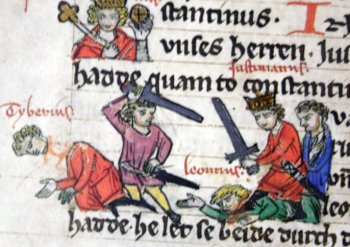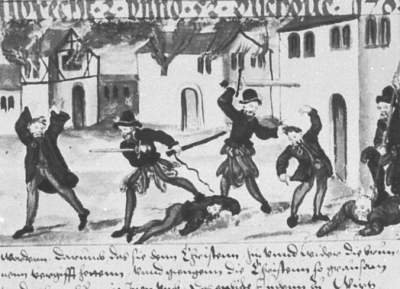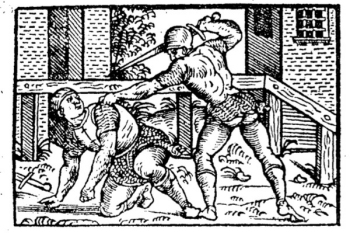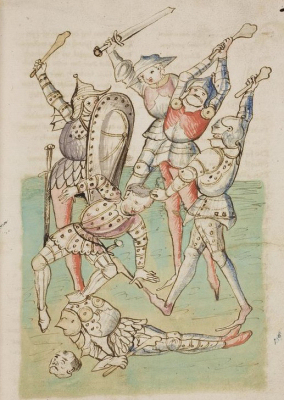
 |
||||||||
|
|
||||||||
How moving fast teaches you
how to slow down
|
|
The Necessity of Practicing Function Over Form in Renaissance Martial Arts Training By John Clements Here is a simple question: What is the most important thing in practicing Mare today? Having been pursuing this craft professionally now since 2001, I've long concluded it is not about knowing techniques, nor being able to do certain moves and approximate various actions from the sources. It is also not about guarding against attacks nor even rapidly striking strong blows. Rather, it is a matter of asking yourself, when moving in violent self-defense, whether or not you look like the images in the sources? That is, when doing combat actions do you and your opponent have the same position of body and limbs and weapons as the authentic sources illustrate? And the only way this is going to occur is not by posing and softly mimicking them as a sort of dance routine, but by executing them with the requisite speed and energy. In other words, stepping and turning and striking or displacing with proper force—the force necessary to deal effectively with a violent encounter. But this force is not going to manifest without correct biomechanics. So, what we are really talking about is using proper form. But that form cannot be acquired or be developed in you as a fighter, as a practitioner, unless you are doing it with the requisite speed and power intrinsically necessary to ward or to injure. To get the proper form to combat motions you have to understand the function of what you are doing, a function which by its nature occurs with violent force. This function is a matter of violent physical action through efficient coordinated motion. So, there is no escaping that you must train with speed and energy. The obvious counter-argument to this is the view that in order to first learn them you have to commit combat actions slowly. But in practice this notoriously permits slow-motion teachings that fail in both theory and execution when they encounter either the real world physics of real world violence or skilled practitioners who don't cooperate with it. In the study of the martial arts of Renaissance Europe it also allows all manner of pernicious and faulty interpretations to go largely unchallenged. When I am teaching to a new student I will demonstrate something at full speed and energy to display that this is your goal, this is how you apply it, this is the motion and action when real power is involved. "How am I doing it it?" I will ask. "Let me show it to you slowly first." So then, when they start practicing it right there I can adjust their form—correct their arms or feet, change their position, posture, or grip, etc. Then they immediately start to perform the movement harder and faster and stronger. Because only through that kind of exercise are they going to understand and appreciate its function. I'm not concerned about some perfect idealized "form" or some prescribed aesthetic, but only the proper function of their motion. I can tell them to strike through air or to hit a practice target again and again, over and over, harder and faster, stopping them only to say, okay, let's fix something. I modify their positioning, have them do it a little slower to see that they comprehend, repeating the process as necessary until it works with optimal power. I continuously explain, demonstrate, and provide feedback. When I train on my own, I will still sometimes go through some motions slowly, precisely because I have the form down already and know how to perform its function at full force and speed. So, when I need to execute something reflexively with explosive power and good martial spirit (emotional content), I can. That I can afford to go through it slowly and practice it casually is due to the fact that I know what I am doing precisely because I also regularly practice it with proper intent. It is a truism of personal self-defense that it is nearly impossible to generate the intensity needed to effectively strike out in sudden violence unless a person is accustomed to striking at things with practiced violence. To once more defer to what the master George Silver so wisely expressed in 1599 when critiquing teachers whose method worked only in the casual exercise of the classroom but failed in both earnest fight and vigorous free-play: "No fight [is] perfect that is not done in force and true time." This is as true now as it was when recognized back then. To quote Archibald Maclaren from his 1864 army saber system: "The perfect use of any weapon can only be acquired by practising its movements with another weapon which resembles and represents it in all essentials, and which yet leaves the combatants free to execute any movement with the utmost freedom and force without risk of injury." Again, it's about the function over the form. Train the way you will actually fight when your life is endangered. And no one seriously fights softly and slowly if they want to live through it. |
 As
I said, starting off moving slowly sounds very logical to most people.
When you first learn to drive, you don't immediately jump on the freeway
and go 75 mph, you start off in a parking lot or a quiet neighborhood
street and work your way up to roads with higher speed limits. As I pick
up a guitar to try and learn to play it, I'm certainly not starting off
trying to shred like Eddie Van Halen, hoping my random pickings will start
to sound more coherent the longer I do it. I'm starting with simple phrases
and scales and build my way up to quicker beats and longer tunes (someday...).
Starting slow and building speed is a valid way to learn many real
world physical skills that can be done very fast. However, that does not
mean that all skills can be best learned this way.
As
I said, starting off moving slowly sounds very logical to most people.
When you first learn to drive, you don't immediately jump on the freeway
and go 75 mph, you start off in a parking lot or a quiet neighborhood
street and work your way up to roads with higher speed limits. As I pick
up a guitar to try and learn to play it, I'm certainly not starting off
trying to shred like Eddie Van Halen, hoping my random pickings will start
to sound more coherent the longer I do it. I'm starting with simple phrases
and scales and build my way up to quicker beats and longer tunes (someday...).
Starting slow and building speed is a valid way to learn many real
world physical skills that can be done very fast. However, that does not
mean that all skills can be best learned this way.
The reason I believe this path of learning does not apply to fighting is because skills like driving and music are not analogous to fighting for one major reason: speed. Driving and music are by nature variable-speed skills. Whether I'm in a Model T or a Bugatti Veyron, I can still travel a thousand miles. James Taylor's Fire & Rain and Van Halen's Eruption on guitar can both move people's emotions. Even a beginner going slow can still accomplish something real, whether driving to the corner store or playing Mary Had a Little Lamb. Fighting for your life, on the other hand, can only be accomplished at one speed: as fast as possible. A slow fight isn't a fight at all; it's an execution. Fighting is all freeway, all rock n' roll, all the time. The approach to learning must be different because being the "James Taylor of martial arts" simply isn't a viable option when somebody is trying to kill you. Self defense is by nature a skill that may be required on the way home from your very first lesson, no matter if you're in Heidelberg in 1389 or New York in 2012. If the goal of learning music is to play songs as soon as possible, the goal of learning martial arts is to survive fights as soon as possible, and the methods of learning must match the minimum skills required to achieve that goal.
 Before
I go any further, let me define what I mean by "speed and force"
in a practice setting. There's a wide range between lazily stepping through
the motions and ramming speed, and I am not telling you to abandon one
extreme for the other. Just because there are no quiet neighborhood roads
in fighting doesn't mean that you have to jump straight to the left lane
on the freeway and go 90 mph your first time out. You can start off in
the right lane and go 45 mph and still get a good feel for how the car
handles, then work your way up, but going 5 mph in the middle lane isn't
going to teach you how to avoid obstacles at 60 mph. It is important to
practice at a speed you can control, where you aren't smacking the ground
or over-rotating your body from sheer momentum, but fast enough that you
are forced to move in a springy manner and to exert some muscular effort
to stop. In ARMA's training program we have an informal scale that has
been in use as long as I've been involved as a student and instructor:
quarter speed, half speed, three quarter speed, and with intent.
Quarter speed is slow enough to examine actions and motions closely. Half
speed is similar, but just barely fast enough to get a feel for things.
Three quarter speed is more or less equivalent to that 45 mph lane on
the freeway, where to understand the action you must deal with the required
energy of its consequences. Lastly, acting with intent means to strike
as you would in an earnest fight, with the requisite power and impact
control, just minus the harm. Experience has proven three quarter speed
to be ideal for developing proper mechanics in early training so that
you can make the best use of the rest of the scale later on. Going any
slower is only for initial demonstration and explanation, not training.
Before
I go any further, let me define what I mean by "speed and force"
in a practice setting. There's a wide range between lazily stepping through
the motions and ramming speed, and I am not telling you to abandon one
extreme for the other. Just because there are no quiet neighborhood roads
in fighting doesn't mean that you have to jump straight to the left lane
on the freeway and go 90 mph your first time out. You can start off in
the right lane and go 45 mph and still get a good feel for how the car
handles, then work your way up, but going 5 mph in the middle lane isn't
going to teach you how to avoid obstacles at 60 mph. It is important to
practice at a speed you can control, where you aren't smacking the ground
or over-rotating your body from sheer momentum, but fast enough that you
are forced to move in a springy manner and to exert some muscular effort
to stop. In ARMA's training program we have an informal scale that has
been in use as long as I've been involved as a student and instructor:
quarter speed, half speed, three quarter speed, and with intent.
Quarter speed is slow enough to examine actions and motions closely. Half
speed is similar, but just barely fast enough to get a feel for things.
Three quarter speed is more or less equivalent to that 45 mph lane on
the freeway, where to understand the action you must deal with the required
energy of its consequences. Lastly, acting with intent means to strike
as you would in an earnest fight, with the requisite power and impact
control, just minus the harm. Experience has proven three quarter speed
to be ideal for developing proper mechanics in early training so that
you can make the best use of the rest of the scale later on. Going any
slower is only for initial demonstration and explanation, not training.
The critical problem with performing martial arts techniques slowly is that without the right frame of reference, the mechanics of the motion are not an accurate predictor of how your body will move at higher velocity. The mass of your body, limbs and weapon move in very specific ways at different speeds. When moving with low speed and low force, small steps are the default, one foot can always remain in contact with the ground, and weapons or body-parts that clash are more likely to "stick together" in a position of mutual equilibrium. At a more athletic pace like three quarter speed, limbs stretch out more, the center of gravity shifts farther, both feet may conceivably leave the ground at some point, and the opposing forces of weapons are much more likely to be unequal, and the rebound forces much higher, requiring greater effort to maintain control or change direction. Each person's body will move differently in response to these forces according to his proportions—a stout, massive body can achieve the same force with less stretching and speed than a light, lean body, but sacrifices distance and time by doing so. Athleticism is an inseparable component of martial arts, and only by moving athletically can you get a true sense of the relative physics involved. The same is true for the perceptual component, where detecting and responding effectively to threats must occur in an instant.
 By
now, many people will point out that any good teacher of martial arts
will often show things done in slow motion, and it is certainly true.
Slowing things down so the eye can follow them is a necessity of good
teaching. However, if you watch John Clements, Aaron Pynenberg or other
experienced students like myself teach, you'll notice that even when we
are demonstrating something in slow motion, we are moving in a way that
is nearly identical in form to what it would look like at a higher speed.
Our bodies, our feet, limbs, weapons, etc., maintain the same exact positions
and range relative to our opponents. Ask a new student to demonstrate
something at high and low speeds and you will usually see very different
form in each. Why? Because the experienced practitioner has developed
an accurate mental template of how his body moves with a weapon in his
hands. Simply put, there is a right way and a wrong way to practice slowly,
and it takes a little bit of experience to know the difference.
By
now, many people will point out that any good teacher of martial arts
will often show things done in slow motion, and it is certainly true.
Slowing things down so the eye can follow them is a necessity of good
teaching. However, if you watch John Clements, Aaron Pynenberg or other
experienced students like myself teach, you'll notice that even when we
are demonstrating something in slow motion, we are moving in a way that
is nearly identical in form to what it would look like at a higher speed.
Our bodies, our feet, limbs, weapons, etc., maintain the same exact positions
and range relative to our opponents. Ask a new student to demonstrate
something at high and low speeds and you will usually see very different
form in each. Why? Because the experienced practitioner has developed
an accurate mental template of how his body moves with a weapon in his
hands. Simply put, there is a right way and a wrong way to practice slowly,
and it takes a little bit of experience to know the difference.
The whole point of executing a technique slowly is to mimic how you expect to move at full speed under adversarial conditions. If your movements are limp, your arms and legs are not extending and your muscles lack tension, then you're not doing it right. In order to mimic your own body at high speed, you first have to know how your body moves at high speed. In order to mimic the way weapons clash at high speed, you first have to experience it. Just as important, the only way to control and affect an opponent acting at high speed is to again know how things work at high speed. The only way to develop an accurate perception of your own mass and momentum in fast motion is to move quickly and learn how to observe yourself and analyze what you're doing in real time. This ability to pay attention to what you're doing is the single most important learning tool you have, but just like movement itself, it requires practice to develop it.
In the beginning it doesn't really matter if you're moving exactly the
right way; the point is that you are training your brain to tune in to
what's going on while you are moving this way so you can recreate the
conditions for later experimentation. Once you've achieved that awareness,
it becomes much easier to modify your motion, rewind things in your head
and speed them up or slow them down as needed because now you know the
proper context in which to consider them.  If
you don't define the context of your actions this way first, then you
are almost guaranteed to start off with faulty assumptions which will
have to be corrected the hard way later.
If
you don't define the context of your actions this way first, then you
are almost guaranteed to start off with faulty assumptions which will
have to be corrected the hard way later.
The next logical question you'll probably ask is: if I'm not moving correctly from the start, won't I teach myself bad habits that I'll have to unlearn later as I gain coordination? From my own decade of experience and the shared experience of many of my teachers and respected peers, I can confidently say the answer is no. Most reliable studies I've seen say it takes at least a thousand repetitions of an action to start developing lasting muscle memory. Even the most subtle of fencing actions are performed under the conditions of speed, force and conviction (or to defer to Master Fiore's term, audacia), but since most of fighting is far from subtle, then the most important priority for a beginner is to acclimate both mind and body to operating at high intensity. Practicing solo cutting exercises, counter-strike drills, and structured free-play with experienced fighters at near-realistic speeds early and often forces your brain to adjust to the demands of the combat environment usually before your body can catch up, greatly improving your ability to recognize, control and refine your movement. It isn't something that takes years of practice to master (as pop culture versions of "traditional" Asian fighting disciplines would have us believe); a few weeks of earnest work will quickly start rewiring the pathways in your brain, but even if you have been at it for years it is a habit that should still be reinforced regularly and often.
By now it should be apparent that I'm not saying you should never practice in slow motion. Sometimes it may be the only way to break things down enough to get a handle on them, but it's important to realize that without sound biomechanics, you can make anything work in slow motion only to discover nasty surprises later when things don't behave the same way at full speed—with an uncooperative assailant. By learning how to function at high speed first, you give your low speed practice more value through improved accuracy in replicating the physics involved. Greater accuracy then begets greater consistency of results as you put your interpretations of the manuals through the paces at varying intensity. In other words, by going fast before you go slow, you are laying the foundations for the bridge between the art and the science of defence.
See Also:
Video: No
Going "Soft and Slow"
|
|
|||
|
|
|||
|
|||